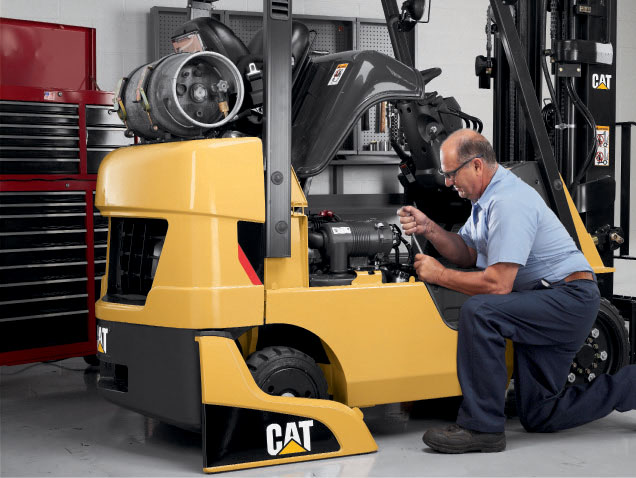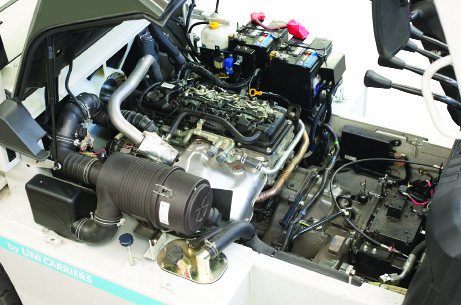Lift Truck Equipment: The Shift Has Begun
Effective parts supply chain management is a critical objective for lift truck dealers, especially as users’ demands for maintenance services continue to rise.
Latest Material Handling News
Avidbots showcases autonomous cleaning robots Traka exhibits modular lockers MRO Survey: Finding and keeping the best technicians Maintenance, Repair and Operations: Understanding the true condition of the equipment Newly formed Bison combines AMETEK DFS and Bison Gear and Engineering Corp. More MROFor much of their history, lift trucks were managed and maintained in-house, with minimal post-sale assistance from dealers. Now that many lift truck users have entered into maintenance agreements with dealers, equipment users no longer have to oversee the minutiae of fleet maintenance. By the same token, dealers and service providers are now challenged to efficiently manage services and parts supplies to ensure the uptime their clients demand.
As original equipment manufacturers (OEMs) develop fleet management solutions, dealers and service providers also leverage many of the same technologies, reporting metrics and inventory management tools.
Parts supply chain management can be complex, but according to the industry experts we spoke to for this article, the best service providers should focus on the following goals:
- improve the accuracy of their storerooms’ parts;
- remove obsolete parts;
- increase fill rates; and
- use scheduled maintenance programs and OEM fleet management programs.
Effective parts supply chain management
Effective parts supply chain management is nearly impossible if dealers do not first ensure their service vans have appropriate parts on board, explains Kevin Fick, director of aftermarket for UniCarriers Americas. Ideally, the parts mix for any given van should be geared to service the models that are most commonly found in customers’ fleets, as opposed to a “warehouse on wheels” that tries to be everything to everyone. Just as storage locations in a warehouse might serve specific SKU and order profiles, vans perform better when more precisely configured. But this is easier said than done.
“This requires the dealer to analyze part fill rates by service vehicle, as opposed to just analyzing their warehouse inventory,” says Fick. “And the parts transactions need to be tied to the vehicle, rather than the warehouse.”
When a customer outsources a service, their primary key performance indicator will be the dealer’s first-time completion ratio, which is mostly affected by whether the technician has the correct part on the van to complete the repair, according to Tony Fedele, chief operating officer of Abel Womack, a Raymond-authorized sales and service provider. “It can sometimes actually be easier to dedicate a van to a specific account than to service a territory out of a van.”
The dealers’ enterprise resource planning (ERP) systems will typically have parts replenishment engines that help them manage inventory, but they should also consider some key benchmarks and capabilities, adds Fedele. In particular, they must have optimal fill rates, so that parts are always available when they are needed. But again, this can get complicated. For instance, before a van leaves the parts warehouse for a customer site, the system might direct the technician to take a part that is not needed at the moment, but will be in the near future. Vans can also hand materials off to one another depending on their location and customer needs. All these transactions must leverage inventories at the main warehouse, the van and the customer site while optimizing the location, availability and cost of each part.

To either maintain or improve upon their fill rates, dealers can configure their ERP systems to forecast their inventories and plan accordingly. As they do, they must also consider variables like average demand, inventory accuracy and part costs.
“Obsolete parts are evil. If parts are scrapped as obsolescent, the cash could have been better served on other parts carrying costs to improve the fill rates of the dealer,” Fedele explains. “Practically speaking, there is a finite amount of inventory a dealer can carry, dictated by the inventory value.”
To eliminate obsolete parts, dealers should implement systematic approaches, including scheduled monthly inventory control meetings in which they review the ages of their parts, says Fedele. As they do, they should also determine which of the parts are returnable, and then return them accordingly—even if they have to pay restocking fees.
Inventory accuracy
Another important practice is improving the accuracy of storerooms to ensure effective parts supply chain management. Wally Wilson, senior consultant at Life Cycle Engineering, advises dealers to use an inventory cycle count process as a means for maintaining the accuracy of their inventory, particularly repair parts. Wilson believes dealers should categorize their inventory according to an A-B-C analysis and classification, while using the following guidelines:
- Critical spare parts should be counted on a quarterly basis—with an anticipated accuracy of 100%.
- “A” items (those that are expensive and either have a shorter order lead time or use parts available from local suppliers, and have standard applications on various types of equipment) are also counted quarterly, and have a projected accuracy of 100%.
- “B” items (cheaper, lower use items that have a standard application on multiple types of equipment) are counted semi-annually, on the other hand, and have an expected accuracy of 95%.
- Finally, “C” items (generally cheap, high-use consumables like nuts, bolts and fittings) are counted once a year, and have a probable accuracy of 90%.
To ensure inventory accuracy, Wilson advises limiting the number of personnel with authority to order parts. Otherwise, the likelihood of redundant orders increases. Dealers should also consider securing their parts rooms in separate areas that can only be used by authorized employees.
“Whether storerooms are on-site or off-site, access has to be limited,” Wilson adds. “A swipe system or key fobs are control methods used by most storerooms. Most importantly, inventory management and storeroom operation should consistently use the same processes, regardless of the location of the storeroom.”
That being said, technology is only as good as the information it is being fed, says Michael Toering, marketing manager for Rapidparts, a subsidiary of Mitsubishi Caterpillar Forklift America.
“The old adage of garbage in, garbage out applies for inventory management, too,” Toering says. “The key for any customer to consider is not whether the provider has the latest and greatest security plan or palm reader, but whether they have a solid written inventory policy that everyone—counter personnel, technicians, all the way up to the dealership general manager—is bound to abide by.”
Scheduled maintenance programs
In addition to effective parts management and inventory accuracy, scheduled maintenance should be an important part of dealers’ service operations, says Toering. When conducted properly and on time, proactive maintenance can prevent small issues from cascading into big ones while saving thousands of dollars in repairs and downtime, he adds.
Customers might choose to conduct their own maintenance, and dealers typically deliver the parts their customers purchase. Dealers often also help their customers organize storage areas, generally by offering consignment cabinets to them. The cabinets will likely feature cheaper items that are used frequently, such as brake parts, bulbs and wheel bearings, whereas more expensive items used less frequently might be held in stock at the dealers’ premises.
“One word of caution,” Toering adds. “It is less important for customers to know that their service provider offers consignments than it is for them to really understand what their chosen partner will provide as an end-to-end maintenance solution, and what that looks like, practically speaking.”
Depending on the sophistication of the customer, they may also receive parts through their ERP systems, and then track and account for them in inventory, Fedele says. “If customers don’t have access to such systems, many will simply track their inventories on a spreadsheet.”
A portal to productivity
To assist their customers as they monitor their inventories, some dealers offer technology that not only tracks the usage of parts by technician, but also provides customers access to a Web portal, particularly if they have larger inventories to observe. From the portal, customers can also develop usage and inventory reports to identify trends and evaluate the performance of the service provider.
“Technology, such as data gathering systems and connected devices, further enhances the value of OEM fleet management,” says Tracy Minto, director of parts sales for Yale Materials Handling Corp. “For example, telemetry allows dealers to schedule period maintenance around actual equipment usage. Before that, they’d make assumptions based on average use figures.”
The online portals are especially useful for customers who have their own service departments, and are interested in acquiring more influence over their budgets and parts inventories, as well as more visibility to their parts spend, Minto adds.

“The portal provides a self-service tool that gives customers the ability to look up parts online, view manuals, and check availability and query pricing from any location,” says Minto. “A centralized portal to manage parts procurement also enables consistent pricing, consolidated purchasing and the ability to track annual parts spend. Ultimately, the effect is improved visibility and predictability for parts budgeting.”
Companies mentioned in this article:
• Abel Womack
• Life Cycle Engineering
• Rapidparts Inc., a subsidiary of Mitsubishi Caterpillar Forklift America
• UniCarriers Americas
• Yale Materials Handling Corporation

Article Topics
MRO News & Resources
Avidbots showcases autonomous cleaning robots Traka exhibits modular lockers MRO Survey: Finding and keeping the best technicians Maintenance, Repair and Operations: Understanding the true condition of the equipment Newly formed Bison combines AMETEK DFS and Bison Gear and Engineering Corp. Building (and maintaining) your maintenance, repair and operations (MRO) tech workforce The power side of lift truck battery and charger maintenance More MROLatest in Materials Handling
Registration open for Pack Expo International 2024 Walmart chooses Swisslog AS/RS and software for third milk processing facility NetLogistik partners with Vuzix subsidiary Moviynt to offer mobility solutions for warehouses Materials Handling Robotics: The new world of heterogeneous robotic integration BSLBATT is looking for new distributors and resellers worldwide Lucas Watson appointed CSO for Körber’s Parcel Logistics business in North America Hyster recognizes Dealers of Distinction for 2023 More Materials HandlingAbout the Author
Subscribe to Materials Handling Magazine

Find out what the world's most innovative companies are doing to improve productivity in their plants and distribution centers.
Start your FREE subscription today.
April 2024 Modern Materials Handling

Latest Resources










